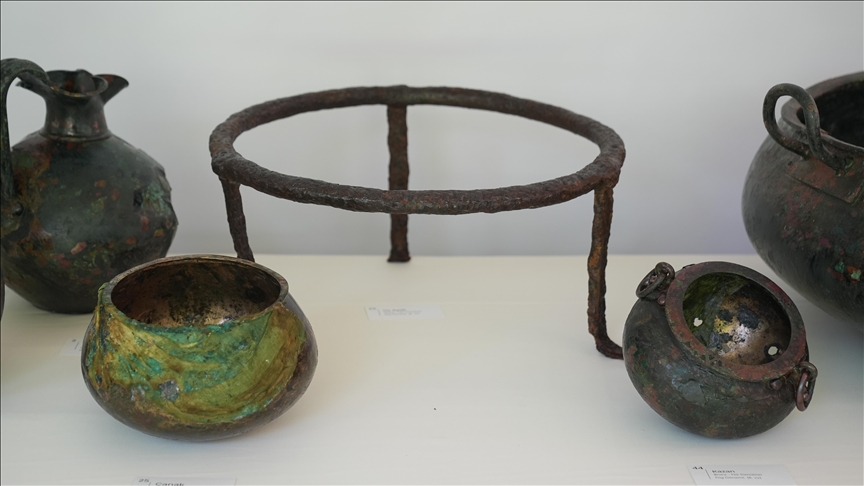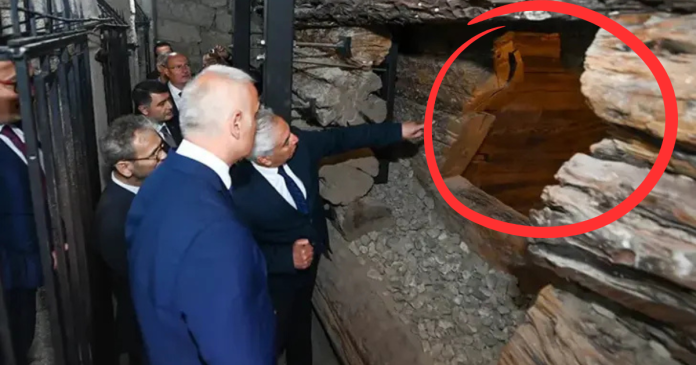GORDION, ANKARA—In a landmark archaeological revelation, Turkish officials announced the discovery of an intact 2,700-year-old wooden burial chamber believed to belong to the Phrygian royal family at the UNESCO World Heritage Site of Gordion. The findings, declared by Culture and Tourism Minister Mehmet Nuri Ersoy on June 4, 2025, represent the most significant funerary discovery at the site since the famed Midas Tumulus.

The Discovery: A Royal Time Capsule
- Tomb Specifications: Excavated within the 47th tumulus (designated T26) at Gordion, the burial chamber measures 3.1 by 2.8 meters and features intricate wooden construction. Its exceptional preservation—untouched by looters—allowed rare insights into Phrygian elite burial customs.
- Artifacts Recovered: Archaeologists uncovered 88 metal objects, including massive cauldrons, bronze vessels suspended by iron nails on the chamber walls, and ceremonial items. Remarkably, many were found “nearly intact”.
- Royal Connection: The richness and craftsmanship of the grave goods—second only to those in King Midas’s tomb—suggest the occupant was likely a member of the royal dynasty linked to King Gordios or Midas (c. 8th century BCE).

Gordion’s Historical Significance
Gordion, the Phrygian capital, gained fame through legends of Alexander the Great untying the “Gordian Knot.” Its archaeological importance began in 1893 during the Berlin-Baghdad Railway construction. The site, added to UNESCO’s World Heritage List in 2023, features over 100 tumuli (earthen burial mounds) built for Phrygian nobles. This discovery reinforces its status as the “identity document of Phrygian civilization”.
Scientific Conservation & Exhibition Plans
- Restoration Process: Artifacts underwent meticulous conservation at Ankara’s Regional Laboratory, where experts removed corrosion, stabilized chemical degradation, and repaired structural damage using mechanical cleaning and microfilling techniques
- Museum Display: Forty-seven conserved items are already at Gordion Museum. The ministry aims to complete in-situ exhibition arrangements for the tomb and all artifacts by late 2025, allowing public viewing of the chamber within its original context.

The Future Heritage Project: Türkiye’s Archaeological Renaissance
Minister Ersoy linked the discovery to Turkey’s nationwide “Future Heritage Project” launched in 2023, which has transformed archaeological practices:
- Year-Round Excavations: Extended fieldwork from 2 months to 12 months per year enabled this meticulous excavation.
- Economic Impact: Created 5,000+ jobs in 2024 alone, with over 6,000 artifacts recovered across 251 Turkish excavation sites.
- International Leadership: Foreign expeditions now include Turkish scientific coordinators, boosting local expertise. Ersoy hailed this as “Turkish archaeology’s golden age”.
Comparative Insight: Gordion’s Tumuli Discoveries
| Tumulus | Era | Key Findings | Significance |
|---|---|---|---|
| Midas | c. 740 BCE | 170+ artifacts, wooden furniture | Largest tomb; identified as King Midas |
| T26 (New Find) | c. 8th cent. BCE | 88 metal objects, bronzes on walls | 2nd richest tomb; royal family link |
| Other 46 | Varied | Diverse aristocratic burials | Context for Phrygian social hierarchy. |
Looking Ahead
The Gordion excavations, co-directed by Prof. Yücel Şenyurt (Hacı Bayram Veli University) and Prof. Charles Brian Rose, will continue analyzing the tomb’s artifacts to pinpoint its occupant’s identity. Meanwhile, the Culture Ministry plans enhanced tourism infrastructure to position Gordion as a global cultural destination. As Ersoy noted: “Anatolia is humanity’s treasure chest—scratch the soil, and you’ll find an ancient city.”
This discovery underscores how strategic investment in heritage is unearthing Türkiye’s deepest historical layers while creating lasting scientific and economic legacies.

